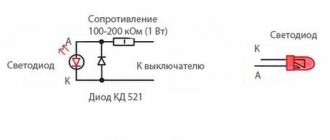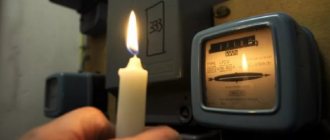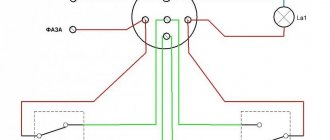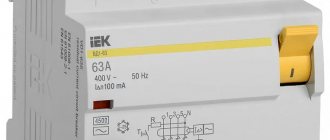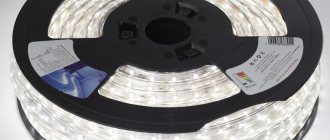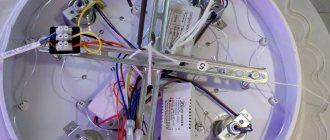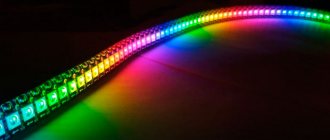A switch with LED or neon lighting is no longer uncommon in homes. The use of such switches is quite practical. In the dark, you don’t have to search along the wall with your hand to find the switch. With the advent of LED and CFL lamps, big problems began to arise. In particular, most modern LED lamps blink when the switch is off. Today we’ll figure out how to turn off the backlight on the switch.
This effect occurs due to a closed electrical circuit formed by a resistor with an LED (or neon lamp) and a power converter circuit for the LED and CFL lamp. In this article we will look at the simplest method on the question: how to turn off the backlight in a switch.
Eliminate flicker. Instructions.
We have noted the main reasons that can lead to the blinking of an LED lamp. Now we will look in detail at how to eliminate complex causes, for which we will provide step-by-step instructions.
How to turn off the backlight in the switch?
If you are one of the lucky ones who purchased a backlit switch but switched to LED lamps, we sympathize. Because rarely do these two phenomena coexist together. The simplest and most popular solution is to turn off the backlight. How to do it?
- Unplug the breaker (whole house).
- Use a measuring device to check the presence of current.
- Use wire cutters to cut off the wires that supply power to the light indicator.
- Reinstall the device. Secure. Apply electricity.
If, after these steps, the LED lamps also glow after turning off or flicker, just change the switch.
- Unplug the breaker or the entire house.
- Check for current.
- Remove the switching device from the box on the wall.
- Remove all wires.
- Screw and secure the new switch, including the wires.
- Apply current and check if the problem with the blinking LED lamp has been resolved.
Removing errors from wiring
The most common errors encountered in wiring are two. Incorrect connection and non-compliance of network parameters with the requirements stated by the manufacturer on the packaging of the llama. Check:
- Where is the phase wire connected (to which contact, what polarity). Presence of induced voltage (parallel cable);
- And if in the first case the problem is eliminated in no time by rearranging the wires, then in the second option all the wiring needs to be repaired.
- If the LED lamp blinks, we either stabilize it with a capacitor or increase the resistance with a resistor.
As we have already mentioned, one of the ways to eliminate the reason why the lamp blinks after turning off is to add a capacitor or resistor to the circuit.
Attach the secondary element to the lamp, placing it on the back of the switch itself or from inside the socket:
- Step 1. Buy a non-polar capacitor that can withstand a power of 630-640 V. This will help stabilize the current. The best solution would be a metal film capacitor.
- Step 2. If you are strengthening the cartridge, you need to buy a resistor, the power of which will depend on the sum of the power of all sockets. Try starting with 25% additional resistance to the existing resistor. If the problem is not solved, increase to 50%. If there are two or more buttons on the switch, you should purchase a separate resistor or capacitor for each. True, take into account the risks, because the design is already quite fire hazardous.
- Step 3: Make sure that none of the added elements are in contact with the housing or wire itself.
The question - why the LED lamp is blinking has been resolved!
We found out why LED light bulbs blink, and it doesn’t matter at all whether the lamps are turned off or on. Gave clear instructions on what to replace, add, buy again
The most important thing to remember is that flickering lamps can harm not only your nervous system, but also cause irreparable damage to your vision. Make the right choice, do not skimp on your health! The pulsation parameters specified by the manufacturer will allow you to understand how much harm such a lighting device can cause to the health of your eyes.
The pulsation parameters specified by the manufacturer will allow you to understand how much harm such a lighting device can cause to the health of your eyes.
Today you can find a switch with LED backlight in almost every home. Using such a switch in the dark is much more convenient, but with the advent of fluorescent and LED lamps, problems began to arise with these “convenient” devices.
Some modern lamps connected through a backlit wall switch flicker even though the light is off. The blinking effect, which is unpleasant for the eye, occurs due to a closed electrical circuit formed by a resistor with an LED (or a resistor and a neon bulb) and a power converter circuit for an LED or fluorescent lamp.
There are several ways to get rid of blinking in a 220V lamp, more on that already. In this article we will consider the simplest and most reliable option in more detail. It consists of removing the backlight from the switch. So how do you turn off the backlight in the switch? First things first.
Lamp glow when the load is off
There are several likely factors that could explain why the lighting element is still lit after being disconnected from the power source, albeit dimly:
- Problems with electrical wiring, in particular, poor-quality insulation on one of the sections of the circuit.
- The LED lamp is connected to a backlit switch.
- Poor quality emitters used in the design of the light source.
- Functional features of the lamp.
If the emitters burn when the switching device is in the off position, it is recommended to first consider all other factors except the first, since it is problematic to determine the area of hidden wiring that is weak in insulation.
To do this, conditions are created under which a circuit breakdown occurs (high voltage is applied for 1 minute). The problem area, due to which the diode lamps glow after the load is turned off, will have to be opened: the integrity of the wall is compromised if the wiring is laid using the gating method.
The problem of cheap LED products is no less common. If a product of low quality at an affordable price was chosen, and usually the connection between these factors is direct, then there is a high probability of an error in the soldering board. But it happens that the emitter, although dimly, burns due to the functional features of the design.
In particular, we are talking about the processes that occur in the resistor when a load is applied to the lamp: this element accumulates energy as current flows through the circuit, and after the load is turned off, it maintains the glow in the emitters.
Why does an LED lamp glow when the switch is off?
Miracles do not happen and I, as an electrician, responsibly declare that if an LED light bulb lights up after turning off, there can be only 2 reasons for this:
- the switch does not break a phase, but a zero, and there is a section in the wiring with poor-quality insulation;
- A backlit switch is used.
Let's consider both cases in more detail.
Illuminated switch
The most common reason for an LED lamp to glow after being turned off is the use of a backlit switch.
Inside such a switch there is an LED with a current-limiting resistor. The LED lamp glows dimly when the lights are turned off because even when the main contact is turned off, current continues to flow through them.
Why does an LED lamp burn at full heat and not at full power? Thanks to the limiting resistor, the current flowing through the electrical circuit is extremely insignificant and insufficient to light an incandescent electric lamp or ignite fluorescent lamps.
What does it look like? There can be two lighting options. Either the LED lamp lights up continuously after turning off, which means that sufficient current flows through the LED backlight of the switch, or the light flashes periodically.
This usually happens if the current flowing through the circuit is too small to cause a constant glow, but it recharges the smoothing capacitor in the power supply circuit.
How to fix? The simplest is to remove it from the backlight switch. To do this, we disassemble the housing and unscrew or bite off with wire cutters the wire going to the resistor and LED. Or change the switch in the house to a regular one, without backlight.
You can purchase such a resistor at any radio store. Installing the resistor is not difficult. It is enough to remove the lampshade and fix the resistance legs in the terminal block for connecting the network wires.
If you are not particularly friendly with electricians and are afraid to “interfere” with the wiring yourself, another way to “fight” backlit switches can be to install a regular incandescent lamp in the chandelier. When turned off, its spiral will act as a shunt resistor. But this method is only possible if the chandelier has several sockets.
Incorrect connection of the lamp
The reason for the continuous burning of the lamp may be hidden in connection errors. If, when installing the switch, a zero was connected instead of a phase, it will turn off when the circuit is opened. At the same time, due to the preserved phase, the wiring (and, accordingly, the light bulb) will be constantly under voltage. The LED light will illuminate when the switch is off, due to leakage current through worn insulation or poorly insulated connections.
Violation of polarity (phase and zero) during installation causes a constant supply of current, which leads to the glow of LED devices even when the switch is off. This situation is quite dangerous for the inhabitants of the apartment: since the device is energized, even if it is turned off. And you can accidentally get an electric shock (for example, when replacing a light bulb).
How to fix? It is necessary to turn off the power supply, disconnect the wires, and then mount them in the correct way (phase to switch).
Connection rules
Regardless of the type, installing an illuminated switch is the same. The differences are only in a couple of nuances.
Installation of a single switch
The easiest way is to connect a single-key (single) backlit switch. First of all, you need to turn off the power and remove the old switch.
For this:
Use a flathead screwdriver to remove the key. Carefully remove the decorative trim. Unscrew the screws connecting the device to the socket box. Pull it out. Loosen the fastenings, disconnect the wires. After completing the manipulations, the inside of the dismantled switch remains on your hands
They are thrown away or used as spare parts
At the end of the manipulations, the inside of the dismantled switch remains on your hands. They are thrown away or used as spare parts.
To install a new light switch with indicator/backlight, you must repeat the steps listed above, only in reverse order:
- Insert the “internals” into the socket box, not forgetting to attach the wires to the switch contacts.
- Screw in the bolts.
- Install a decorative frame.
- Insert a key.
- Turn on the electricity to check the correct installation and connection. If the work is done correctly, the diode in the backlight will light up.
Installation and connection of switches with several keys
Connecting a double or triple backlit switch is done in much the same way. To install a design with two keys, you will need a screwdriver, side cutters, tips and an indicator with which to determine the phase.
The work is carried out like this:
As in the previous case, first of all it is necessary to turn off the power to the apartment/house. Next, the dismantling of the old device begins. Remove the keys and unscrew the screws. There will be three wires left in the socket box. One is incoming power, two more are power going to the lighting fixture. Now, using an indicator screwdriver, you need to find the phase wire, mark it or simply remember it
You need to act extremely carefully, because this stage requires the presence of voltage in the network. Disconnect the network. Strip the wires of insulation. Get a new device. It has three contact groups and a pair of wires coming from the backlight. Using a measuring device, determine the “Off” position.
Typically, the wiring coming from the LED has special contact plates for screws. The screw must be unscrewed, placed against the plate and screwed back. Repeat the action for the remaining contacts. Attach the phase wire to a plate located separately from the rest with a screw. Connect the wire going to the chandelier to the contact and secure it. Secure the last wire under the contact on which there are no plates. Check that the connection is correct. Insert the inner part of the switch into the installation box. Secure the screws. Reinstall the keys.
Upon completion of installation, connect the electricity and check the functionality of the device.
If it is necessary to control the light source from different places, a pass-through/changeover switch should be installed. Its main difference from classical models is the presence of a moving contact. If you press the on/off key, it will transfer from one contact to another, starting the operation of the second circuit.
Connecting a pass-through switch with backlight
The connection diagram for the pass-through switch is extremely simple. Two separate devices are installed on both sides of the circuit.
To do this, you will need to lay a three-core cable to one and to the other. When the first switch is turned on, the circuit will close and the lamp will light. When the second one is turned on, the light will turn off.
More reasons why LED lights blink when the switch is off
The problem may be due to poor installation of lighting fixtures. For example, if there is no gap between the contact plane of the lamp and the surface of the wall/ceiling where it is installed, then a powerful LED, heating up, emits light of greater brightness, which cannot be properly controlled by the capacitor. As a result, the light blinks when the light is off.
Increased humidity in a room (for example, a bathroom) leads to oxidation. Oxides do not conduct current well, so an oxidized contact pad will provoke pulsation of an already turned off LED.
Nature of the outbreak
The first thing you need to understand is the nature of the outbreak. This will help you figure out the most likely reason.
Work with electricians only with the switch off!
1) The flickering is periodic. On state. Reasons: starter failure. The problem when the mode is off is the presence of a powerful source of electromagnetic waves, such as a telephone, radio, computer, or router, nearby.
2) Flashing when turned on. Reasons: low voltage, power surges. If you do not get rid of the problem, the device will burn out.
Cheap LED headlights installed in a car are very blinding to oncoming cars.
How to install the backlight in the switch yourself
You can make an indicator in the switch yourself. The sequence of operations is as follows:
- Repeat the steps above (see steps 1–9).
- Solder into the switch (to the input and output contacts) an assembled chain of a resistor and an LED. It is better to add a regular diode to the circuit, connected opposite the indicator to protect it from reverse current.
- Install the switch using the reverse sequence of steps and check its operation.
This circuit is installed if incandescent lamps are used in the lamps. When in the off position, current flows through the resistor and the LED, causing it to glow. The current in this case is about 3 mA, which is quite enough to power an LED light bulb.
There is also a circuit for connecting the backlight on a neon lamp. Its advantage is that any light bulbs can be used in lamps and chandeliers: LED, fluorescent, incandescent.
If you install neon lighting instead of an LED, the switch will work with all types of lamps
As we said above, there is also a scheme for making a backlit switch on a capacitor. Thanks to the capacitor, the backlight system operates more stable and consumes less energy than in the case of resistance. But you can’t use it with LED lamps either.
The capacitor circuit can be used with halogen and incandescent lamps
How does it work, how does it work?
To understand the reasons and eliminate them, consider the principle of operation of the device and its components.
This type of product consists of a base, a base made of metal, a platform with LEDs, a driver, and a plastic hemisphere.
When a conventional incandescent lamp was operating, voltage was applied to the coil, which was the load resistance. In the case of an LED, the circuit is modified: the current passes from the base to the electronic converter in the form of a driver, after which it goes to the LEDs themselves. The stabilization of the process depends on the complexity of the converter circuit.
For cheap ones, the driver substitute is not able to withstand external influences from the network; for more expensive products, such “outbreaks” occur much less frequently.
LED lighting devices are among the safest.
How to eliminate the flickering problem and its causes will be discussed below.
Is it possible to turn off the backlight and how to do it
Let's assume that we don't need the LED to work at all. For example, we have a room in which there is always some kind of additional lighting. In this case, it is easy to turn the backlit device into a regular one.
To do this, we completely disassemble the removed switch according to the previously described scenario (that is, we remove the keys and remove the lining). Then we simply remove the small backlight bulb.
- If its feeding tendrils are inserted into the corresponding holes, then this unit can only be pulled out with your fingers.
- If the antennae are soldered into the device, you need to arm yourself with a small soldering iron and plug it into the network. After two to three minutes the tool will heat up. Now you need to carefully, holding the soldering iron solely by the handle, touch the soldering areas with the tip. After a while, you can pull the light bulb towards you.
In order to disconnect the light bulb, it is enough to touch the soldering points with the heated tip of the soldering iron one by one and pull it towards you
Master light switch - turn off the light with one button
Greetings, dear readers of the site elektrik-sam.info!
The second, most popular option when ordering a project or assembly of an electrical panel, after non-switchable lines, is a master lighting switch.
We live in a busy world where everyone is constantly overloaded with information and is constantly in a hurry.
Therefore, it is very convenient when leaving an apartment or house to turn off all the lighting at once with one click on the switch, and turn your attention to everyday worries, without worrying about forgetting to turn off the lights in one of the rooms. This explains the demand for such a solution in the home electrical network!
Technically, a master lighting switch can be implemented in various ways, but the main executive element in them will be a contactor.
When using a contactor we will have two circuits:
- control circuit, the control mechanism is included in it (most often a push-button or key switch);
- power circuit, controls the power connection to our lighting lines and fixtures.
Control circuit
The contactor winding is connected to the control circuit through a control mechanism - a key or push-button switch, a pulse relay, a card switch, a Touch Memory controller, etc.
Those. When a switch or other mechanism is closed, supply voltage is supplied to the contactor winding and it operates.
Contactors with normally open contacts are most often used. When power is supplied to the contactor winding, its power contacts close. Accordingly, when the master switch is turned off, it breaks the control circuit, power is removed from the contactor winding, the power contacts are opened and the lighting circuits of the apartment (house) are de-energized.
Contactors are produced with windings designed for different supply voltages, for example, Hager: 12V AC, 24V AC, 230V AC.
Contactors with 12V and 24V windings are widely used in automation systems. The most functional solution for organizing a master switch would be to use a programmable logic controller or a programmable relay; they use contactors with 12V or 24V windings.
The control circuit, like any electrical circuit, must additionally be protected by a protection device or fuse link.
Power circuit
The contactor winding, connected to the control circuit, controls the closing/opening of its power contacts. It is the power contacts that connect or disconnect the load (in our case, lighting groups) to the power supply network.
The power contacts of the contactor are designed for a certain current that they can pass, completing the circuit. The rated current of the contacts is indicated on the front panel of the contactor in amperes; it must be calculated when selecting and select the nearest higher rating from the model range.
It is imperative to provide a higher-level protection device in the circuit switched by the contactor.
Contactors are available in versions for single-phase or three-phase networks. Three-phase contactors for the master switch are used if you have a three-phase power supply and lighting groups are distributed over three phases.
For the master lighting switch, it is advisable to use manually operated contactors. They are more expensive than usual and are not always available in stock, but in the event of any accident they allow you to turn on/off the power circuit of the contactor manually.
Master light switch technical implementation
Regarding technical implementation, I will highlight three main, most often used solutions.
- A master switch with a contactor is installed in the power supply circuit of the lighting group. By pressing the button (key) of the switch, the contactor connects/disconnects power from the group lighting circuit of the apartment. This is the most common option.
- Centralized lighting control by a master switch, when all lighting in the apartment is based on pulse relays. A more complex and expensive solution requires the use of special additional modules in conjunction with pulse relays. An example of such a shield.
- The most universal and functional solution is using a PLC programmable logic controller. Allows you to programmatically change lighting scenarios. Sometimes, depending on the equipment used, it may be cheaper than the option for pulse relays. We will consider the technical implementation of such automation systems in subsequent publications.
As you can see, there are many solutions for organizing lighting control with a master switch, but all of them are based on the use of a contactor.
Source
Turning off the backlight
Initially, all actions for dismantling a neon lamp or LED completely coincide with the work of replacing a conventional switch:
- blackout of a room or apartment;
- removing the decorative on/off key from the latches, slightly prying it off on both sides;
- unscrewing the mounting bolts and removing the device from the mounting box;
- Use an indicator screwdriver to double-check the wire contacts for the absence of voltage;
- Having remembered the connection diagrams, the wires are disconnected.
Then you need to carefully examine the design of the illuminated switch and find the latches that hold the two parts of the housing together. By opening the latches, the switch will be divided into two halves. In one of them a resistor is soldered or screwed to a neon light bulb or LED.
All that remains is to carefully cut the terminals of the radio components, remove them and assemble the switch without backlighting in the reverse order.
Manufacturers of backlit switches do not always indicate that the use of these devices is recommended in electrical circuits with a predominantly resistive load. That is, the light source must be incandescent lamps.
Even more often, the technical data sheet of a product is sent to the trash bin unread, along with the packaging. The consequences of such technical nihilism appear immediately after fluorescent or LED lamps begin to be used instead of incandescent lamps. Even de-energized (it would seem) they somehow flicker in the dark.
This phenomenon not only causes psychological discomfort, but also leads to their premature failure.
To understand the physical essence of this phenomenon, you need to look inside both the switch itself and the light source
. Let's try to figure out why the LED lamp blinks, and whether a backlit switch could be the reason for this.
Operating principle of the lighting device
For the backlight device, a circuit is added that is parallel to the switched contacts. Its main element is LED or neon
. The resistance of this additional circuit is much higher than that of short-circuited contacts.
When the switch is in the "on" position, no electricity passes through it. And in the “off” position it, bypassing the open main contacts, reaches the load
If it is resistive, then its strength is not enough for the thread to heat up to glow.
If fluorescent or LED lighting devices are used, then the load is reactive in nature, since to ensure the operation of these light sources, a circuit consisting of capacitors, coils and semiconductor devices
. It can also work with low current.
What turns on the light
Both LED and fluorescent ones operate not from alternating mains voltage, but from constant voltage. To do this, a device (driver) is placed in their sockets.
, which rectifies the current and performs some other actions. For example, the final stage of a fluorescent lamp control circuit is a high-voltage transformer, which ensures the occurrence of an arc discharge in a gaseous environment.
The LED lamp driver circuit is somewhat simpler. It consists of capacitors and ballast resistors that provide protection for semiconductor devices that are connected in series, due to which the supply voltage is divided between them.
All driver circuits have two common elements
. The first is the so-called diode bridge, which cuts the alternating voltage sinusoid and converts it into a series of pulses of the same sign. The second is an electrolytic capacitor parallel to it. At the moment when the voltage drops to zero, the capacitor discharges and smoothes out the gap between the pulse peaks. It is this element that causes the unauthorized operation of the lamp.
The weak current from the backlight circuit is still rectified, but the process of charging the capacitor is very slow. In the end, it is filled to the brim with electricity and discharges at the moment the rectified voltage drops to zero again. This is enough for a short-term occurrence of an arc discharge in a gas environment
or ensuring the operation of a chain of series-connected LEDs.
For luminescent lamps, this mode is harmful for the reason that their service life is determined by the number of starts. In a few minutes of blinking it can be completely used up. LEDs are more tolerant of intermittent operation
How to fix the problem
Illuminated switch is a very practical device
, making life easier. There is no point in giving it up for the sake of using modern light sources. To prevent light bulbs from blinking due to a backlit switch, you can use one of two methods:
- Increase the ballast resistance of the additional circuit;
- Use a resistive or capacitive shunt.
In the additional circuit of the switch there is already resistance (). It is installed in series with a neon or LED. If you increase the value of the resistor, the current flowing through it will be even weaker
. Then the capacitor after the driver rectifier bridge will not be fully charged due to natural losses.
The disadvantage of this method is the difficulty of selecting the value of the ballast resistance - if it is too large, the backlight will stop working. In addition, it is quite technically difficult. You must have truly golden hands.
The simplest resistive shunt is 40 W. The resistance of its cold thread is no more than 100 Ohms. This is less than the driver input impedance. All current from the backlight will go through it
. However, different light sources in a chandelier are very unsightly. But the bypass process is extremely simple.
It can be replaced by a resistor with a nominal value of 100 Ohms for circuits with a voltage of 250–400 volts
. It is installed between the wire from which the cable is laid to the switch.
If you can’t get to it (for example, it’s covered with wallpaper), then a shunt resistor can be soldered to the input wires of the chandelier.
The disadvantage of this method is that the shunt resistor can heat up
.
The capacitive shunt takes electricity from the capacitor, which causes light sources to flicker. Just use not an electrolytic (having the polarity of the terminals) element, but an oil-paper element, marked with the ≈ sign and designed for a voltage of 250–400 volts
. Its capacitance should not exceed 1 µF. It is mounted in exactly the same way as a resistive shunt - between the phase and neutral wires.
Incorrect installation also causes de-energized lamps to glow. For example, if the neutral wire is switched, and not the phase wire. In addition, the flickering intensity of luminescent housekeepers is influenced by the quality of their manufacture.
. It is best to carry out work on bridging the circuit breaker during its installation.
When connecting energy-saving or LED lamps to a backlit switch, the lamps do not go out completely or blink. In our video review, we suggest you look at options for solving this problem:
Did you like the video? Subscribe to our channel!
Switches with an indicator (backlit) are convenient devices that allow you to quickly find the switch in a dark room. Illumination is carried out using a neon lamp installed in the switch housing.
With their appearance, the functionality of the switches has increased, but the problems have not decreased. After all, each mechanism has its own characteristics.
How does the switch work?
The phase coming to this switch is connected to L - the incoming contact (Fig. 2), and from the outgoing contacts it goes to the lighting lamps. The moving contacts are closed to each other.
A backlight circuit is installed, which includes a resistor and a “neon” - a neon light bulb, and is soldered to contacts L1 and L. Thus, when contacts L and L1 are open, the neon light bulb is lit, and when the light is turned on, these contacts are closed by a moving contact, which eliminates backlight circuit diagrams.
What should you pay attention to?
When choosing a switch with an indicator, it is necessary to operate with the power consumption of all lighting devices connected to the switch. The markings and rated current (maximum permissible) current are indicated on the inside of the switch. Basically, switches are manufactured for currents of 10 and 16 A and, accordingly, the maximum connection power for them is 2.2 and 3.5 kW.
It should also be noted that you should not use backlit switches to work with energy-saving (fluorescent) lamps. Because when turned off, the energy-saving lamp flickers, and this “behavior” of the lamp is unlikely to please anyone.
Currently, there are special types of lighting devices - a flickering candle lamp, which imitate the fluttering of a flame in the wind.
Types of switches and operating principles
Based on the number of switched chains and the number of keys, all existing types of switches are divided into the following types:
- single-key models;
- two-key samples;
- three-key devices.
Another type of old device is still in use, in which the element that controls the switch mechanism is more like a button.
In addition, rare types of rotary-type switching products are presented on the domestic market. In terms of control method, they are a bit like a packet switch. There are also inexpensive Chinese devices related to touch sensitive devices. To control them, you don’t need much effort - just put your finger on the contact plate.
The operating principle of a conventional type switch is based on the closure of the moving and fixed contacts when the key is moved to the upper position and their opening when the reverse action occurs. The so-called “pass-through” switch works in the same way, differing from the usual one in the presence of additional groups of contacts, as well as in the method of inclusion in the lighting network.
Types of switches for home use
Each manufacturer produces different models of switches, which differ both in shape and internal structure. However, several main types should be distinguished.
Table 1. Types of switches by switching principle
| View | Description |
| Mechanical | Devices that are easy to install. Instead of the usual button, some models have a lever or cord. |
| Sensory | The device works at the touch of your hand, and you do not need to press a key. |
| With remote control | This design is equipped with a special remote control, which comes included, or a sensor that responds to movements around. |
The most popular is the first option, which is installed everywhere. Moreover, such switches have become in demand since the very beginning of the appearance of the electrical circuit. The second option is less popular, especially in our country. The third option is a modern model, which is gradually displacing outdated switches from the market.
Installing a motion sensor in a structure is advisable both from the point of view of energy savings and home safety. For example, if you install a structure at the entrance, residents will notice if intruders break into the apartment.
Switch with additional lighting
Depending on their design features, there are devices with one or several buttons (on average, for standard electrical appliances, switches with two or three buttons are used). Each button is responsible for turning on and off a separate circuit.
So, if several lamps are installed in one room at once: the main chandelier, spotlights, sconces, then it would be advisable to install a design with three buttons.
In addition, no less popular are devices with two buttons, which are installed in all apartments without exception. Most often they are needed for a chandelier when there are many light bulbs.
Depending on the installation method, there are internal and external switches. The first option is installed in the apartment, because such structures look aesthetically pleasing. For safety during installation, a special box is installed, which is called a socket box.
Connection diagram
Built-in switches are used when there is electrical wiring hidden in the wall. Overhead devices are mounted in the presence of external conductors. In this case, the connection diagram has no fundamental differences.
Where is the switch installed?
Low frequency flickering of LED lamps
The amplitude of the alternating mains voltage changes with a frequency of 50 times/sec and has the form of a sinusoid. The luminescence of the matrix is provided exclusively by positive and negative half-waves passing through the LED. If a light source equipped with LEDs blinks, this may be the reason for significant savings on the power supply by the manufacturer.
In inexpensive models of such lighting equipment, a single-bridge rectifier is often used to reduce its cost, designed to convert AC voltage to DC. A certain number of oscillations are cut off after the diode bridge, and by adding a capacitor to the electrical circuit, ripple is reduced. Such a scheme allows you to observe the pulsation of the light flux with a frequency of 25 times/sec.
The capacitor, as a rule, accumulates charge at the amplitude maximum and returns it to the load at the minimum. At the output, the average voltage amplitude decreases, and the ripple becomes significantly less. If the resource capacity is insufficient, the capacitor is not enough to recharge the LED elements, whose brightness changes with each half-wave. According to sanitary standards, the pulsation of the light flux should not be more than 10 percent of the nominal intensity.
Technical features
These parts decrease their resistance as the temperature increases when compared to metal components. Unfortunately, this has the disadvantages that the current can increase to uncontrollable levels. The same thing happens with heating; accordingly, after a while after operating at such a peak, the diode fails.
Also, such a part is very sensitive to an increase in voltage, so even the smallest impulse can break it. Accordingly, the manufacturer must select resistors as accurately as possible. Moreover, the diode may break if the voltage is reversed polarity. It should be noted that this component only copes with the passage of current in positive sequence.
Even with such disadvantages, switches with diodes are in demand.
Types of switches depending on the type of backlight
There are several categories of lighting for switches:
- With current limiting resistor. The disadvantage of this scheme is that it does not work if LED lamps are installed in home lamps and chandeliers. This is due to the fact that when using them it is impossible to create a high current for illumination (the resistance of LED lamps is much greater than that of incandescent lamps). Energy-saving lamps with this scheme can glow in the dark.
- On an LED with a capacitor. A backlight with a capacitor is used to increase efficiency and reduce power consumption when the backlight is operating. The resistor here serves to limit the charging current of the capacitor.
- With neon light. Switches with neon lighting have virtually no disadvantages. Here, any lamps can be used throughout the house: fluorescent, LED, incandescent.
If the backlight is broken or not working properly
If after installation or during operation the light inside the switch stops lighting, it is necessary to carry out diagnostics and repairs.
- We dismantle the switch by removing the keys, the lining and unscrewing the screws of the mustache.
- We remove the ends of the wires from the contacts by loosening the bolts. The mechanism appears in front of us.
- We switch it to the position corresponding to resistance measurement with a scale of up to 200 kOhm (the arrow on the central switch should point to the “200K” icon on the device body). When the probes of the device touch each other, a sound should appear. It means that the electrical circuit of the multimeter has no breaks.
- We substitute one probe of the device to the first terminal of the LED, and the other to the second. If the signal is not heard, it means the node has burned out.
- According to the scenario described earlier, we remove the LED or solder it with a soldering iron.
- We buy the same one at a radio parts store. An LED for illumination can be purchased at any radio parts store.
- If the LED was simply inserted into the socket, then install a new one with a slight movement of the hand. Otherwise, we solder it, acting in the reverse order of soldering. You may need a little solder here.
After replacing the LED, it is necessary to mount the described device back to its original location.
Switch backlight
The most important reason for blinking of switched-off LED and energy-saving light bulbs is the presence of backlight in the switch.
When the switch is turned off, a small current still continues to flow through the backlight circuit, charging the filter capacitor. Having charged, the capacitor tries to start the lamp power circuit, but there is not enough “power” and it immediately discharges, and the light flashes briefly. Then it all repeats itself over and over again. There are 6 common methods for eliminating the flickering of switched off energy-saving lamps:
- shunting with a resistor
- capacitor bypass
- connecting the backlight with a separate wire
- using a pass-through switch
- dismantling the backlight inside the switch
- connecting a conventional LED light bulb in parallel
Samsung
For laptops with backlit keyboards, there is a quick keyboard shortcut to control this feature: Fn + F9 .
After all these steps, reboot the system and check the function keys Fn + F9 . If the work does not work out, then ask for help from the company’s user support service.
Before you try to activate the backlight on your MSI laptop, make sure that this mode is supported by your gadget. For example, you can check this on the brand’s website.
If this is possible, then there should be a button with a backlight icon on the keyboard panel. Click it to launch the function. If the light does not appear, then it may simply be set to the minimum brightness setting. Control the brightness of the backlight using keyboard shortcuts:
If such actions do not bring results, then try updating or reinstalling the SSE / Dragon Center driver .
You can control whether the keyboard backlight is turned on or off by simultaneously pressing Fn + F9 . But if the F9 key does not have a logo with the letter A and a backlight image, then most likely this function does not exist on your device.
In rare cases, there are models where the combination of hot keys for turning on the backlight looks like this: Fn + F6
If the key combination does not work, refer to the next chapter of our article.
Expert opinion
It-Technology, Electrical power and electronics specialist
Ask questions to the “Specialist for modernization of energy generation systems”
Conclusion. Drawing conclusions This usually happens if the current flowing through the circuit is too insignificant for a constant glow, but it recharges the smoothing capacitor in the power circuit circuit. Ask, I'm in touch!
Power calculation
You also need to calculate the power dissipated by the resistor; it is calculated using the formula:
where P is the power dissipated by the resistor (W);
Uc – mains voltage (here 220 V);
Usd – LED operating voltage (V);
Isd – LED operating current (A);
We calculate the power: Pmin=(220-2)*0.01 = 2.18 W, Pmax=(220-2)*0.02=4.36 W. As follows from the calculation, the power dissipated by the resistor is quite significant.
Of the resistor power ratings, the closest larger one is 5 W, but such a resistor is quite large in size, and it will not be possible to hide it in the switch body, and it is irrational to waste electricity.
Since the calculation was carried out for the maximum permissible current of the LED, and in this mode its durability is greatly reduced, by reducing the current by half, you can kill two birds with one stone: reduce power dissipation and increase the service life of the LED. To do this, you just need to double the resistance of the resistor to 22-39 kOhm.
Connecting the backlight to the switch terminals
The figure above shows a diagram for connecting the backlight to the switch terminals. The phase wire of the network goes to one terminal, the wire from the light bulb goes to the second, the backlight is connected to these two terminals. When the switch is open, current flows through the backlight circuit and it lights up, but the light bulb does not light up. If the switch is closed, the voltage will flow through the circuit, bypassing the backlight, and the lighting will turn on.
Factory backlit switches most often use the circuit shown in the figure above. The resistor value is from 100 to 200 kOhm; manufacturers deliberately reduce the current through the LED to 1-2 mA, and therefore the brightness of the light, because at night this is quite enough. At the same time, power dissipation is reduced; you don’t have to install a protective diode, because the reverse voltage does not exceed the permissible value.
Let's start from the beginning
To understand the use of such a sensory apparatus, it is necessary to understand what it is. Externally, the touch switch designed for the LED strip looks like a crystal panel. The corresponding markings are applied to this panel. Varieties of household models are used to connect to a 220 volt network. The product connection diagram will be given below. The touch switch type may vary in:
Touch switch option
Today, this kind of product is used for the following purposes:
connecting LED strip. This approach has worked well in the kitchen when using LED strip to illuminate the work surface. And connecting a touch-type switch to it greatly simplifies work indoors in the evening and at night;
Note! Modern technologies that allow you to automate or simplify the switching on of lights belong to the “smart home” system. This also includes the touch switch. Remote control for LED strip
Remote control for LED strip
- connecting sconces;
- control of different levels of lighting for multi-level ceilings. Here again we are talking about LED lighting, organized using a strip (single or multi-color). For the convenience of such control, you can use the remote control;
- control of the main lighting system in a house or apartment. You can also use the touch remote control here.
In whatever situation the switch is used (for an LED strip or other type of lighting), you need to remember that the connection diagram can be different. For the tape, due to a number of circumstances, one scheme is used, and for other light sources another scheme is suitable.
Note! The connection diagram, if you use a remote control to control the level of illumination, will also be slightly different. You can either buy a touch switch in a specialized store or make it yourself. It is worth noting that you can install it quite easily with your own hands.
Installation can be carried out in the kitchen or in any other room. But in the kitchen you will need an aluminum profile for this
It is worth noting that you can install it quite easily with your own hands. Installation can be carried out in the kitchen or in any other room. But in the kitchen you will need an aluminum profile for this
You can either buy a touch switch in a specialized store or make it yourself. It is worth noting that you can install it quite easily with your own hands. Installation can be carried out in the kitchen or in any other room. But in the kitchen you will need an aluminum profile for this.
Driver circuit for LEDs in a chandelier
The circuit is very simple, maybe it will be useful for someone in repairs:
Driver for powering serial chandelier LEDs. Electric scheme
Briefly the device. Ballast limit chain – C1, C2, R1. Most of the voltage drops on this circuit. Next, the alternating voltage is supplied to the diode bridge, and then to the filter R3, C3, R2.
If you need to slightly increase the voltage at the driver output under load (i.e., reduce its output resistance, see the part of the article with calculations), then you can increase the capacitance of the filter capacitor to 10...20 μF. Then the number of LEDs can be increased slightly.
And if you need to reduce the number of LEDs in a chandelier (for example, some have burned out), then you can reduce the ballast capacity by removing one of the capacitors C1, C2. It's experimental.
Calculator for calculating the parameters of a current-limiting resistor
When installing it yourself in a backlight switch on an LED or neon light bulb, it is necessary to determine the size and power of the current-limiting resistance. The calculation can be done using formulas, but it is much more convenient to calculate the resistor parameters using a special calculator. Just enter the parameters and get the finished result. The calculator can also be useful for selecting a resistor in a factory-made backlit switch in case the resistor fails.
| Online calculator for calculating the rating and power of a current-limiting resistor |
| Power supply voltage U, V: |
| Voltage drop across one LED or neon bulb, V: |
| Number of LED or neon lamps connected in series, pcs: |
| Maximum permissible current through an LED or neon bulb, mA: |
Reference. On an LED the voltage drop is in the range of 1.5-2 V, on a neon bulb it drops 40-80 V. The required minimum current at which the LED is guaranteed to glow is 2 mA, for a neon bulb - 0.1 mA. This data can be used for calculations on a calculator if the parameters of an LED or neon bulb are unknown.
When choosing a resistance, it becomes necessary to determine its value by color marking. will help resolve this issue.
Using a backlight circuit for display
The backlight of the switch performs another additional useful function - it indicates the functionality of the switch and the serviceability of the light bulb. If the backlight works, but the light does not turn on, then the switch is faulty. If the backlight does not work, then the light bulb has burned out.
Any of the above presented circuit options can be used to indicate the health of devices or electrical circuits. For example, if you connect it in parallel with a fuse, then if it blows, the indicator will light up. If an electrical appliance does not have a standard on indicator, then by connecting the indicator immediately after the switch, you can always see whether the appliance is on. When installed in a socket (connected parallel to the current-carrying wires), you will know whether the socket is energized or not.
Preparation for installation
At the preparatory stage, draw up a power supply diagram for lighting devices with a detailed location of all batteries, spotlights, strips and switches. This procedure can be conveniently carried out on the factory plan of the cabinet that comes with it. Then transfer the diagram to the cabinet frame, mark the equipment installation points and cable routing.
To complete the work, you will need some materials and tools that should be prepared in advance:
- LED strips or spotlights;
- power wires - selected according to power consumption;
- power supply for connecting 12 V cabinet lighting equipment;
- controller for connecting RGB strip;
- light box for organizing closed LED strips;
- terminal connectors, solder and flux for making electrical connections;
- key switch, button or control panel for switching cabinet lighting.
The tool you will need is a drill with attachments for making round holes in wardrobes or kitchen cabinets. A screwdriver or screwdriver for working with fasteners, a construction stapler, a soldering iron. Bench tools - pliers, wire cutters, stationery knife, scissors, etc. If you have everything you need, you can proceed directly to installing the lighting.
What to do if the switch needs to be moved
In some situations, there is a desire or need to move the switch to another location. For example, when there are children in the family who have already grown up, but cannot yet reach the top switch. Therefore, according to the rules for installing electrical equipment, it is permitted to move the device to another location.
The benefits of replacing the switch yourself
It is allowed to mount the switch at a distance from 82 to 165 centimeters from the floor level. However, in order to begin work on moving equipment, you must first decide on the exact location of its installation. It is recommended to place the switch at a distance of no more than 25 centimeters from the door frame (the side does not matter, but more often the device is located on the right).
The switch can be mounted on each side of the door
Moving the switch - step-by-step instructions
Step 1. If you move the equipment within 100 centimeters from the existing position down or up, then make a groove in the ceiling. As a rule, it has a depth of 2 times the cross-section of the cable in the corrugation. So, the wire should not stick out from the opening. You can prepare such a recess using a hammer drill or a special tool for grooves.
Prices for popular models of wall chasers
Wall chaser
This is what a cable groove looks like in the ceiling
Step 2. Now, directly at the installation site of the new switch, you need to make a recess for the mounting bowl. This is done using the same hammer drill and a special round attachment. If the wall is concrete, then the depth of the opening will be about 50 millimeters, and if it is brick or panel, then 45 millimeters. The diameter of the nozzle itself will be about 7 centimeters (selected individually).
This is what the opening for the mounting bowl looks like
Step 3. Now you need to completely de-energize the apartment and dismantle the old switch (using the method we discussed above). Only here, in addition to the switch, the mounting bowl is removed from the wall. To do this you will need the same hammer or a hammer with a flat screwdriver. Most often, socket boxes are fixed with gypsum mortar, which begins to crumble upon impact.
It is important not to damage the integrity of the plastic base.
It is necessary to carefully remove the mounting bowl from the wall
Step 4. Now you should extend the cable to the required length. The wires, as a rule, are connected with special clamps or a block, but if this is not possible, then their ends are bunched together and then insulated. According to the installation rules, the cable must be in a special plastic corrugation with a diameter of about 1.6 centimeters. It is also necessary to wrap insulating tape at the junction of the two parts of the corrugation. When extending the cable, you must leave a few centimeters as reserve.
There should be no exposed wires, so they are wrapped with insulation tape
Step 5. Now you need to install the mounting bowl in the new opening; it will be easier to fix it using alabaster, which contains gypsum. Since the plaster begins to harden within a few seconds, it is quickly diluted with water according to the instructions, and then the hole is covered.
You need to work with alabaster quickly before it has time to harden.
Step 6. The grooves in the ceiling must also be covered with the solution. In this case, the wiring should be laid according to all the rules, because it will no longer be possible to change its location. Then the surface of the wall must be finished with finishing putty in order to completely hide the locations of the grooves. When the surface dries, it is treated with fine-grained sandpaper.
Prices for popular types of putty
Putties
The grooves should also be puttied
The switch should be connected only after the solution has hardened. Therefore, you will have to wait a few hours.
If you plan to move the switch a significant distance from its original location, then most likely it will need to be connected to another box. In this case, it is advisable to seek help from an experienced electrician.

